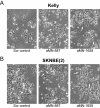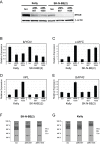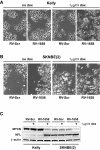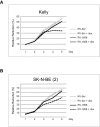Conditional expression of retrovirally delivered anti-MYCN shRNA as an in vitro model system to study neuronal differentiation in MYCN-amplified neuroblastoma
- PMID: 21194500
- PMCID: PMC3022612
- DOI: 10.1186/1471-213X-11-1
Conditional expression of retrovirally delivered anti-MYCN shRNA as an in vitro model system to study neuronal differentiation in MYCN-amplified neuroblastoma
Abstract
Background: Neuroblastoma is a childhood cancer derived from immature cells of the sympathetic nervous system. The disease is clinically heterogeneous, ranging from neuronal differentiated benign ganglioneuromas to aggressive metastatic tumours with poor prognosis. Amplification of the MYCN oncogene is a well established poor prognostic factor found in up to 40% of high risk neuroblastomas.Using neuroblastoma cell lines to study neuronal differentiation in vitro is now well established. Several protocols, including exposure to various agents and growth factors, will differentiate neuroblastoma cell lines into neuron-like cells. These cells are characterized by a neuronal morphology with long extensively branched neurites and expression of several neurospecific markers.
Results: In this study we use retrovirally delivered inducible short-hairpin RNA (shRNA) modules to knock down MYCN expression in MYCN-amplified (MNA) neuroblastoma cell lines. By addition of the inducer doxycycline, we show that the Kelly and SK-N-BE(2) neuroblastoma cell lines efficiently differentiate into neuron-like cells with an extensive network of neurites. These cells are further characterized by increased expression of the neuronal differentiation markers NFL and GAP43. In addition, we show that induced expression of retrovirally delivered anti-MYCN shRNA inhibits cell proliferation by increasing the fraction of MNA neuroblastoma cells in the G1 phase of the cell cycle and that the clonogenic growth potential of these cells was also dramatically reduced.
Conclusion: We have developed an efficient MYCN-knockdown in vitro model system to study neuronal differentiation in MNA neuroblastomas.
Figures







References
-
- Kitanaka C, Kato K, Ijiri R, Sakurada K, Tomiyama A, Noguchi K. et al.Increased Ras expression and caspase-independent neuroblastoma cell death: possible mechanism of spontaneous neuroblastoma regression. J Natl Cancer Inst. 2002;94:358–368. - PubMed
-
- Bolande RP. The spontaneous regression of neuroblastoma. Experimental evidence for a natural host immunity. Pathol Annu. 1991;26(Pt 2):187–199. - PubMed
Publication types
MeSH terms
Substances
LinkOut - more resources
Full Text Sources
Medical

